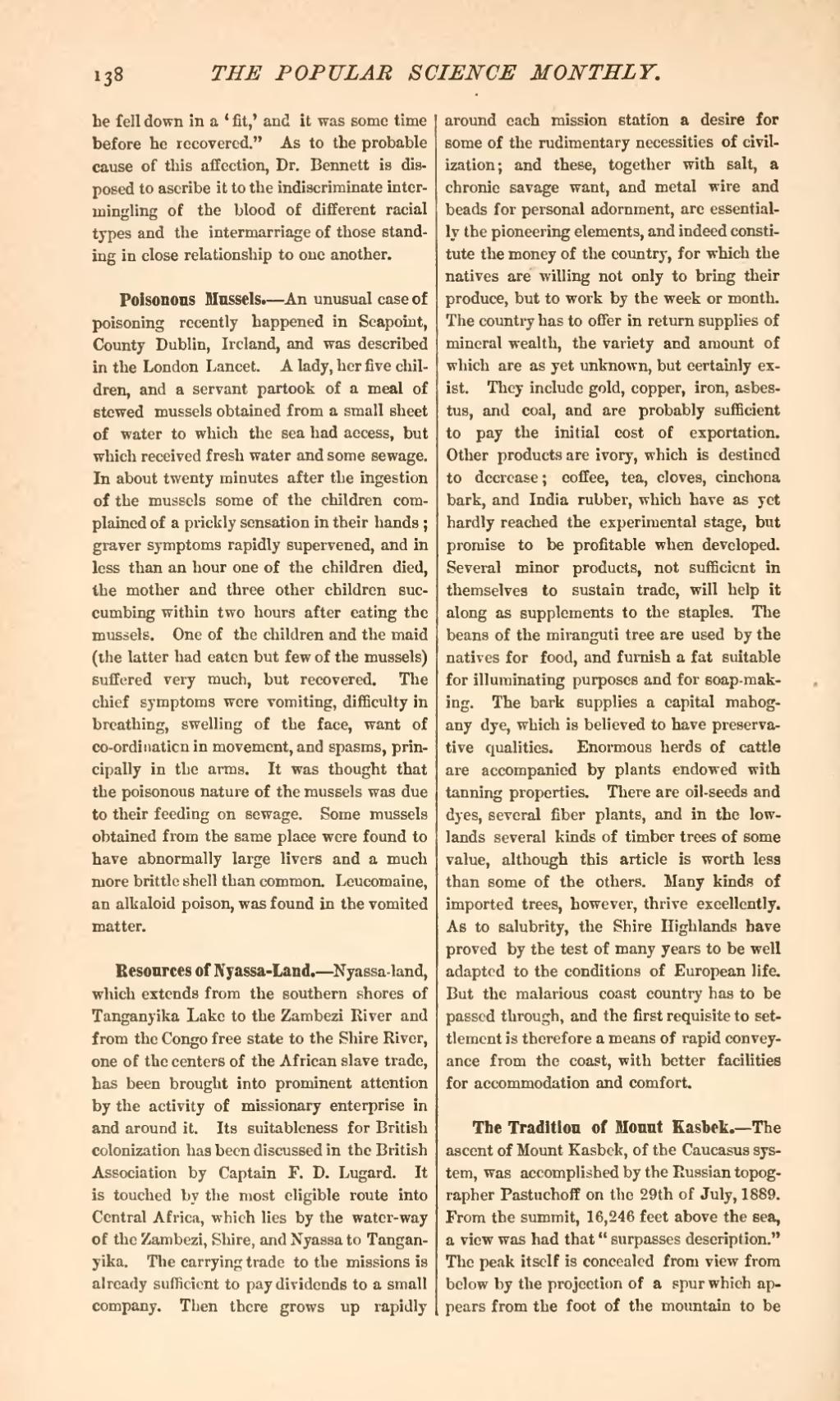he fell down in a 'fit,' and it was some time before he recovered." As to the probable cause of this affection, Dr. Bennett is disposed to ascribe it to the indiscriminate intermingling of the blood of different racial types and the intermarriage of those standing in close relationship to one another.
Poisonous Mussels.—An unusual case of poisoning recently happened in Seapoint, County Dublin, Ireland, and was described in the London Lancet. A lady, her five children, and a servant partook of a meal of stewed mussels obtained from a small sheet of water to which the sea had access, but which received fresh water and some sewage. In about twenty minutes after the ingestion of the mussels some of the children complained of a prickly sensation in their hands; graver symptoms rapidly supervened, and in less than an hour one of the children died, the mother and three other children succumbing within two hours after eating the mussels. One of the children and the maid (the latter had eaten but few of the mussels) suffered very much, but recovered. The chief symptoms were vomiting, difficulty in breathing, swelling of the face, want of co-ordinaticn in movement, and spasms, principally in the arms. It was thought that the poisonous nature of the mussels was due to their feeding on sewage. Some mussels obtained from the same place were found to have abnormally large livers and a much more brittle shell than common. Leucomaine, an alkaloid poison, was found in the vomited matter.
Resources of Nyassa-Land.—Nyassa-land, which extends from the southern shores of Tanganyika Lake to the Zambezi River and from the Congo free state to the Shire River, one of the centers of the African slave trade, has been brought into prominent attention by the activity of missionary enterprise in and around it. Its suitableness for British colonization has been discussed in the British Association by Captain F. D. Lugard. It is touched by the most eligible route into Central Africa, which lies by the water-way of the Zambezi, Shire, and Nyassa to Tanganyika. The carrying trade to the missions is already sufficient to pay dividends to a small company. Then there grows up rapidly around each mission station a desire for some of the rudimentary necessities of civilization; and these, together with salt, a chronic 6avage want, and metal wire and beads for personal adornment, are essentially the pioneering elements, and indeed constitute the money of the country, for which the natives are willing not only to bring their produce, but to work by the week or month. The country has to offer in return supplies of mineral wealth, the variety and amount of which are as yet unknown, but certainly exist. They include gold, copper, iron, asbestus, and coal, and are probably sufficient to pay the initial cost of exportation. Other products are ivory, which is destined to decrease; coffee, tea, cloves, cinchona bark, and India rubber, which have as yet hardly reached the experimental stage, but promise to be profitable when developed. Several minor products, not sufficient in themselves to sustain trade, will help it along as supplements to the staples. The beans of the miranguti tree are used by the natives for food, and furnish a fat suitable for illuminating purposes and for soap-making. The bark supplies a capital mahogany dye, which is believed to have preservative qualities. Enormous herds of cattle are accompanied by plants endowed with tanning properties. There are oil-seeds and dyes, several fiber plants, and in the lowlands several kinds of timber trees of some value, although this article is worth less than some of the others. Many kinds of imported trees, however, thrive excellently. As to salubrity, the Shire Highlands have proved by the test of many years to be well adapted to the conditions of European life. But the malarious coast country has to be passed through, and the first requisite to settlement is therefore a means of rapid conveyance from the coast, with better facilities for accommodation and comfort.
The Tradition of Mount Kasbek.—The ascent of Mount Kasbek, of the Caucasus system, was accomplished by the Russian topographer Pastuchoff on the 29th of July, 1889. From the summit, 16,246 feet above the sea, a view was had that "surpasses description." The peak itself is concealed from view from below by the projection of a spur which appears from the foot of the mountain to be

